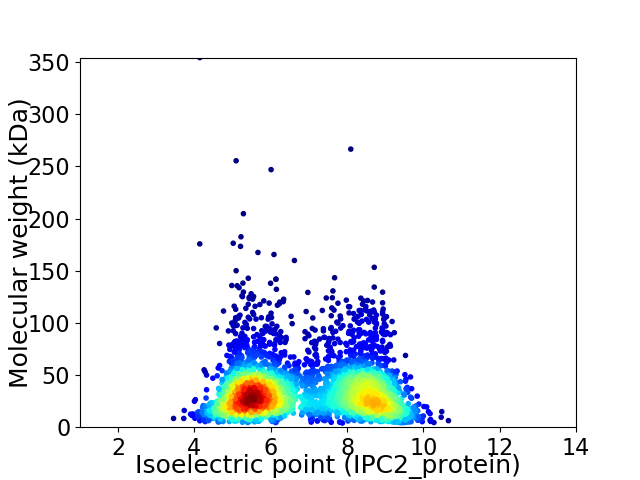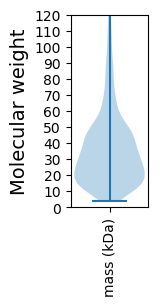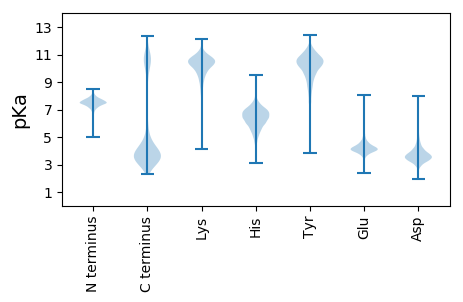
Daejeonella lutea
Taxonomy: cellular organisms; Bacteria; FCB group; Bacteroidetes/Chlorobi group; Bacteroidetes; Sphingobacteriia; Sphingobacteriales; Sphingobacteriaceae; Daejeonella
Average proteome isoelectric point is 6.85
Get precalculated fractions of proteins

Virtual 2D-PAGE plot for 3561 proteins (isoelectric point calculated using IPC2_protein)
Get csv file with sequences according to given criteria:
* You can choose from 21 different methods for calculating isoelectric point
Summary statistics related to proteome-wise predictions



Protein with the lowest isoelectric point:
>tr|A0A1T5A1N8|A0A1T5A1N8_9SPHI TonB dependent receptor OS=Daejeonella lutea OX=572036 GN=SAMN05661099_0211 PE=4 SV=1
MM1 pKa = 7.63KK2 pKa = 10.47EE3 pKa = 3.46NDD5 pKa = 3.95FYY7 pKa = 11.66LSTEE11 pKa = 3.57IKK13 pKa = 10.34YY14 pKa = 10.71NCLDD18 pKa = 3.68VVKK21 pKa = 9.83MWGTDD26 pKa = 3.77FEE28 pKa = 5.18LKK30 pKa = 10.52VYY32 pKa = 10.86SLTDD36 pKa = 2.9TDD38 pKa = 4.64YY39 pKa = 11.43EE40 pKa = 4.23VAEE43 pKa = 4.33NCIEE47 pKa = 4.15LYY49 pKa = 10.74GDD51 pKa = 3.95SRR53 pKa = 11.84PDD55 pKa = 3.35LYY57 pKa = 11.36AFEE60 pKa = 4.85VSLDD64 pKa = 3.78DD65 pKa = 4.09EE66 pKa = 4.75LSYY69 pKa = 11.28DD70 pKa = 3.84YY71 pKa = 11.03MNDD74 pKa = 3.51AITWYY79 pKa = 9.83ASHH82 pKa = 7.02IGKK85 pKa = 9.24PDD87 pKa = 3.43MEE89 pKa = 4.75ILRR92 pKa = 11.84TDD94 pKa = 3.12PRR96 pKa = 11.84EE97 pKa = 4.13DD98 pKa = 3.49FLEE101 pKa = 4.93GSLPKK106 pKa = 10.66VGII109 pKa = 4.09
MM1 pKa = 7.63KK2 pKa = 10.47EE3 pKa = 3.46NDD5 pKa = 3.95FYY7 pKa = 11.66LSTEE11 pKa = 3.57IKK13 pKa = 10.34YY14 pKa = 10.71NCLDD18 pKa = 3.68VVKK21 pKa = 9.83MWGTDD26 pKa = 3.77FEE28 pKa = 5.18LKK30 pKa = 10.52VYY32 pKa = 10.86SLTDD36 pKa = 2.9TDD38 pKa = 4.64YY39 pKa = 11.43EE40 pKa = 4.23VAEE43 pKa = 4.33NCIEE47 pKa = 4.15LYY49 pKa = 10.74GDD51 pKa = 3.95SRR53 pKa = 11.84PDD55 pKa = 3.35LYY57 pKa = 11.36AFEE60 pKa = 4.85VSLDD64 pKa = 3.78DD65 pKa = 4.09EE66 pKa = 4.75LSYY69 pKa = 11.28DD70 pKa = 3.84YY71 pKa = 11.03MNDD74 pKa = 3.51AITWYY79 pKa = 9.83ASHH82 pKa = 7.02IGKK85 pKa = 9.24PDD87 pKa = 3.43MEE89 pKa = 4.75ILRR92 pKa = 11.84TDD94 pKa = 3.12PRR96 pKa = 11.84EE97 pKa = 4.13DD98 pKa = 3.49FLEE101 pKa = 4.93GSLPKK106 pKa = 10.66VGII109 pKa = 4.09
Molecular weight: 12.73 kDa
Isoelectric point according different methods:
Protein with the highest isoelectric point:
>tr|A0A1T5ARF0|A0A1T5ARF0_9SPHI 2'-5' RNA ligase OS=Daejeonella lutea OX=572036 GN=SAMN05661099_0951 PE=4 SV=1
MM1 pKa = 7.63RR2 pKa = 11.84FSFIVLRR9 pKa = 11.84KK10 pKa = 8.63NRR12 pKa = 11.84KK13 pKa = 7.79FLRR16 pKa = 11.84LLFASASLFVRR27 pKa = 11.84FRR29 pKa = 11.84FAFCSLCFRR38 pKa = 11.84VCSEE42 pKa = 3.83TASYY46 pKa = 11.01LLRR49 pKa = 11.84DD50 pKa = 3.78RR51 pKa = 11.84FGKK54 pKa = 10.31ASCIFRR60 pKa = 11.84LFFGRR65 pKa = 11.84KK66 pKa = 6.61FNRR69 pKa = 11.84VSTDD73 pKa = 3.43FVYY76 pKa = 10.96SSVPVLRR83 pKa = 11.84GNAGYY88 pKa = 7.92RR89 pKa = 11.84TASEE93 pKa = 4.48GDD95 pKa = 3.5LKK97 pKa = 11.02NCRR100 pKa = 11.84IRR102 pKa = 11.84LGVGNNLISITYY114 pKa = 9.9DD115 pKa = 2.96KK116 pKa = 10.79RR117 pKa = 11.84SKK119 pKa = 10.86NDD121 pKa = 3.18QILVSRR127 pKa = 11.84KK128 pKa = 7.32TLSQSYY134 pKa = 10.41LSDD137 pKa = 3.8NFRR140 pKa = 11.84QDD142 pKa = 2.61IKK144 pKa = 10.95CQEE147 pKa = 4.07KK148 pKa = 10.85LPTGVLLKK156 pKa = 10.82AILYY160 pKa = 8.71LII162 pKa = 4.6
MM1 pKa = 7.63RR2 pKa = 11.84FSFIVLRR9 pKa = 11.84KK10 pKa = 8.63NRR12 pKa = 11.84KK13 pKa = 7.79FLRR16 pKa = 11.84LLFASASLFVRR27 pKa = 11.84FRR29 pKa = 11.84FAFCSLCFRR38 pKa = 11.84VCSEE42 pKa = 3.83TASYY46 pKa = 11.01LLRR49 pKa = 11.84DD50 pKa = 3.78RR51 pKa = 11.84FGKK54 pKa = 10.31ASCIFRR60 pKa = 11.84LFFGRR65 pKa = 11.84KK66 pKa = 6.61FNRR69 pKa = 11.84VSTDD73 pKa = 3.43FVYY76 pKa = 10.96SSVPVLRR83 pKa = 11.84GNAGYY88 pKa = 7.92RR89 pKa = 11.84TASEE93 pKa = 4.48GDD95 pKa = 3.5LKK97 pKa = 11.02NCRR100 pKa = 11.84IRR102 pKa = 11.84LGVGNNLISITYY114 pKa = 9.9DD115 pKa = 2.96KK116 pKa = 10.79RR117 pKa = 11.84SKK119 pKa = 10.86NDD121 pKa = 3.18QILVSRR127 pKa = 11.84KK128 pKa = 7.32TLSQSYY134 pKa = 10.41LSDD137 pKa = 3.8NFRR140 pKa = 11.84QDD142 pKa = 2.61IKK144 pKa = 10.95CQEE147 pKa = 4.07KK148 pKa = 10.85LPTGVLLKK156 pKa = 10.82AILYY160 pKa = 8.71LII162 pKa = 4.6
Molecular weight: 18.79 kDa
Isoelectric point according different methods:
Peptides (in silico digests for buttom-up proteomics)
Below you can find in silico digests of the whole proteome with Trypsin, Chymotrypsin, Trypsin+LysC, LysN, ArgC proteases suitable for different mass spec machines.| Try ESI |
 |
|---|
| ChTry ESI |
 |
|---|
| ArgC ESI |
 |
|---|
| LysN ESI |
 |
|---|
| TryLysC ESI |
 |
|---|
| Try MALDI |
 |
|---|
| ChTry MALDI |
 |
|---|
| ArgC MALDI |
 |
|---|
| LysN MALDI |
 |
|---|
| TryLysC MALDI |
 |
|---|
| Try LTQ |
 |
|---|
| ChTry LTQ |
 |
|---|
| ArgC LTQ |
 |
|---|
| LysN LTQ |
 |
|---|
| TryLysC LTQ |
 |
|---|
| Try MSlow |
 |
|---|
| ChTry MSlow |
 |
|---|
| ArgC MSlow |
 |
|---|
| LysN MSlow |
 |
|---|
| TryLysC MSlow |
 |
|---|
| Try MShigh |
 |
|---|
| ChTry MShigh |
 |
|---|
| ArgC MShigh |
 |
|---|
| LysN MShigh |
 |
|---|
| TryLysC MShigh |
 |
|---|
General Statistics
Number of major isoforms |
Number of additional isoforms |
Number of all proteins |
Number of amino acids |
Min. Seq. Length |
Max. Seq. Length |
Avg. Seq. Length |
Avg. Mol. Weight |
|---|---|---|---|---|---|---|---|
0 |
1196146 |
38 |
3472 |
335.9 |
37.56 |
Amino acid frequency
Ala |
Cys |
Asp |
Glu |
Phe |
Gly |
His |
Ile |
Lys |
Leu |
|---|---|---|---|---|---|---|---|---|---|
7.285 ± 0.038 | 0.762 ± 0.015 |
5.416 ± 0.025 | 5.85 ± 0.044 |
4.957 ± 0.03 | 7.038 ± 0.041 |
1.779 ± 0.019 | 7.438 ± 0.035 |
6.909 ± 0.036 | 9.426 ± 0.047 |
Met |
Asn |
Gln |
Pro |
Arg |
Ser |
Thr |
Val |
Trp |
Tyr |
|---|---|---|---|---|---|---|---|---|---|
2.362 ± 0.02 | 5.43 ± 0.039 |
3.896 ± 0.029 | 3.376 ± 0.023 |
4.253 ± 0.026 | 6.888 ± 0.032 |
5.607 ± 0.05 | 6.437 ± 0.03 |
1.097 ± 0.015 | 3.795 ± 0.027 |
Most of the basic statistics you can see at this page can be downloaded from this CSV file
Proteome-pI is available under Creative Commons Attribution-NoDerivs license, for more details see here
| Reference: Kozlowski LP. Proteome-pI 2.0: Proteome Isoelectric Point Database Update. Nucleic Acids Res. 2021, doi: 10.1093/nar/gkab944 | Contact: Lukasz P. Kozlowski |
